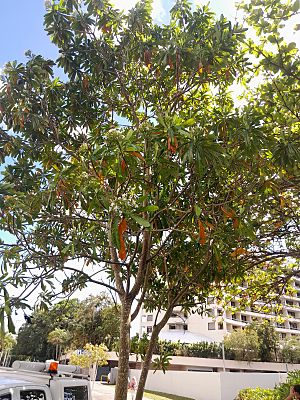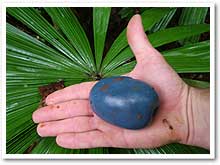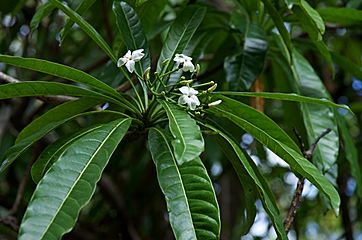Cassowary plum facts for kids
Quick facts for kids Cassowary plum |
|
|---|---|
 |
|
| Street tree in Cairns, Queensland | |
| Conservation status | |
| Scientific classification | |
| Genus: |
Cerbera
|
| Species: |
floribunda
|
| Synonyms | |
|
|
The Cerbera floribunda, often called the cassowary plum, is a special tree. People also know it as grey milkwood, brebong, biegbau, or babai. This tree grows naturally in New Guinea and Tropical North Queensland, Australia. It's famous because its fruit is a favorite food for the southern cassowary, a large bird that cannot fly.
Contents
What the Cassowary Plum Looks Like
The cassowary plum tree can grow very tall, up to 30 meters (about 100 feet). When it is about three years old, it starts to make flowers. These white flowers have red centers and usually appear in July. After the flowers, the tree grows its special fruit. The fruit is large, smooth, and shaped like an egg. It is blue when it ripens, which happens from January onwards.
The Cassowary's Special Meal
Cassowaries love to eat cassowary plums, which is how the tree got its name. The sap inside the plum is poisonous to most animals, including humans. But cassowaries can eat the fruit without getting sick. This is because they have a very fast digestive system. The fruit passes through them quickly, mostly whole. Also, their stomachs have special chemicals that stop the poisons from harming them.
This relationship between the cassowary and the plum tree is a type of symbiosis. This means they help each other. The plum tree gives food to the cassowary. In return, the cassowary helps the tree by spreading its seeds. When the bird eats the fruit whole, the seeds pass through its body. The cassowary's stomach even helps to prepare the seeds for growing. Plums are more likely to grow into new trees after a cassowary has eaten them.
Other Animals and the Plum
Another animal that can eat the cassowary plum is the white-tailed rat. However, this rat does not help the seeds grow like the cassowary does. The rat tears off the poisonous skin of the fruit and eats only the seeds inside.
Uses of the Tree
The wood from the cassowary plum tree has been used for different things. In places like Bougainville and other parts of Papua New Guinea, people use the timber for making decorative parts of buildings. In the Solomon Islands, the wood is used for carvings and sometimes in traditional medicine.
Why You Should Not Eat It
It is very important to know that the fruits of the cassowary plum are poisonous to humans. Like many plants in its family, Cerbera species contain a substance called cerberin. If a person eats the fruit, they might feel sick with nausea, vomiting, or stomach pain. Eating too much could even be very dangerous. The white sap that comes from any part of the tree can also irritate your skin if you touch it. So, it's best to admire this tree and its fruit from a safe distance!
Gallery






